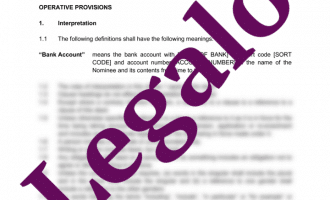Declaration of Trust for Bank Account
Our Declaration of Trust for Bank Account template:
- drafted by an experienced UK solicitor
- simple form, for quick completion
- covered by our money-back guarantee
- easy to complete

How Does It Work?
-
1. Download
-
2. Edit
-
3. Print
-
4. Sign
This is our template for a Declaration of Trust for a Bank Account. If you have a trustee operating a bank account for you, then use this declaration of trust to make it clear the account is your asset and not theirs. It should safeguard the asset whether:
- the bank providing the account thinks it is the trustee’s money; or
- if the trustee dies and someone thinks the money was the trustee’s.
Effectively, the trustee will act as your nominee and follow your instructions.
Bare trust
Our template sets up a bare trust (i.e. showing the bank account is held for one person or a small group of named persons in set percentages), not a discretionary trust (i.e one where the beneficiaries are unknown but will come from a group of named people, with the actual beneficiary/ies to be set later on).

Why use a Declaration of Trust for a Bank Account?
Sometimes you need this where it is difficult for a person to operate a certain bank account. Perhaps this is because it is in a different country. It is very important to ensure the person appointed as trustee is honest, reliable and trustworthy.
Issues regarding the bank account
It is best if you get the declaration of trust signed as soon as the trustee opens the account. Then you would want to send a copy of it to the bank in most cases. This is so that the bank does not think the trustee owns the money. If it did, then the bank might want to take the money back if the trustee personally owed the bank money. So ensure you receive an acknowledgement from the bank that they are not treating the money as belonging to the trustee.
NB the bank may set certain requirements. As a minimum, it may well want to complete the anti-money-laundering ID checks on the beneficiary.
For more about nominee trusts, of which this is one, please see Wikipedia.

Registering your new declaration of trust for bank account with HMRC
Since 6 October 2020, you have to register all new trusts with HMRC, even if it is not taxable. The deadline is 90 days from the date of creation of the trust to register it. Find out more and register your trust here.
Other trust templates available from Legalo
If you have other assets in trust you may like some of our other templates:
All of our templates are expertly drafted by an experienced UK solicitor. They all come with a thorough written guide to each clause, so make it easy for you to use the template. A preview of the main of part of the guide is below. If you need any further help, our helpline is available: just contact us.
Clauses in this Declaration of Trust for Bank Account
Date – Insert just the year at this stage. Handwrite the rest of the date in the deed once the nominee has signed it.
Party clauses – You will need to insert the names and addresses of party 1 (the nominee) and party 2 (the beneficial owner). If either of parties 1 and 2 is a company, then replace the wording for it as applicable using the format:
“[COMPANY NAME] incorporated and registered in [COUNTRY OF INCORPORATION] with company number [NUMBER] whose registered office is at [REGISTERED OFFICE ADDRESS]”
Numbered clauses
1. Interpretation
This clause defines the main terms used in the declaration.
- Bank Account – fill in the details – the bank name, sort code and account number.
2. Declaration of trust
This is the main clause, which states that the nominee holds the bank account in trust for the beneficial owner. It refers to the things the Nominee will do or will not do.
3. Undertaking
Clause 3.1 provides that the nominee will account to the beneficial owner for any interest or other benefits received from the bank account and only deal with it in accordance with the way he is directed to by the beneficial owner. It also says that if the beneficial owner asks for the cash in the account to be transferred to him or to another nominee, then the nominee will obey.
4. Power of attorney
This gives a power of attorney in favour of the beneficial owner. This protects the beneficial owner in case the nominee does not follow his directions. It acts as security.



